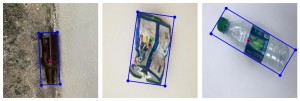What are the most significant risks that could jeopardize the success of the project? How are these risks being managed? What contingency plans are ready?
The most significant risk we could face right is that our expectations of our software and hardware do not match reality. In order to mitigate this we have employed a lot of unit testing to verify our assumptions. For example for the machine learning pipeline, we are trying to pay close attention to the dataset we are training on (we are watching out for class imbalance, lighting, resolution, and etc) to ensure that what we train on will be indicative of reality. The current contingency plan for this is to keep looking for data and potential aggregate multiple datasets together. Another risk is the fact that the end effector we choose may not be compatible with a considerable amount of the objects we intend on working with. In that case, we intend on possibly purchasing another end effector such as a gripper with the remaining funds, in addition to the suction type end effector.
Were any changes made to the existing design of the system (requirements, block diagram, system spec, etc)? Why was this change necessary, what costs does the change incur, and how will these costs be mitigated going forward?
No major changes have been made yet, however, we still need to decide on the final specs for the camera (720p vs 1080p).
Provide an updated schedule if changes have occurred.
No schedule changes have been made.

